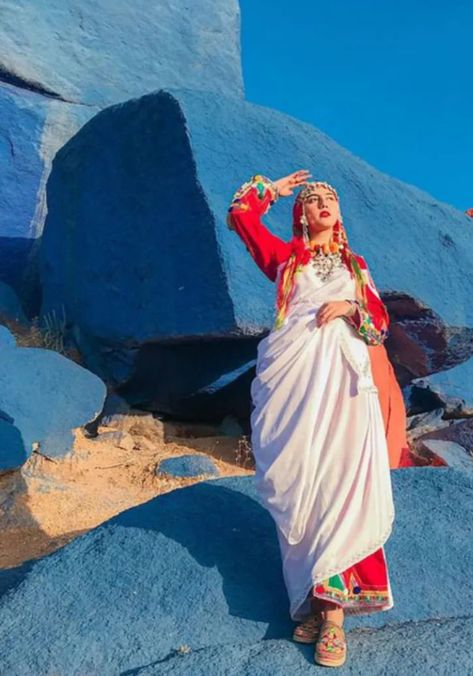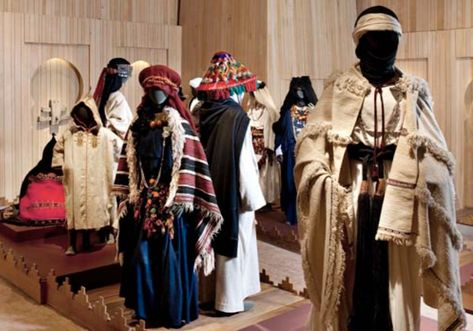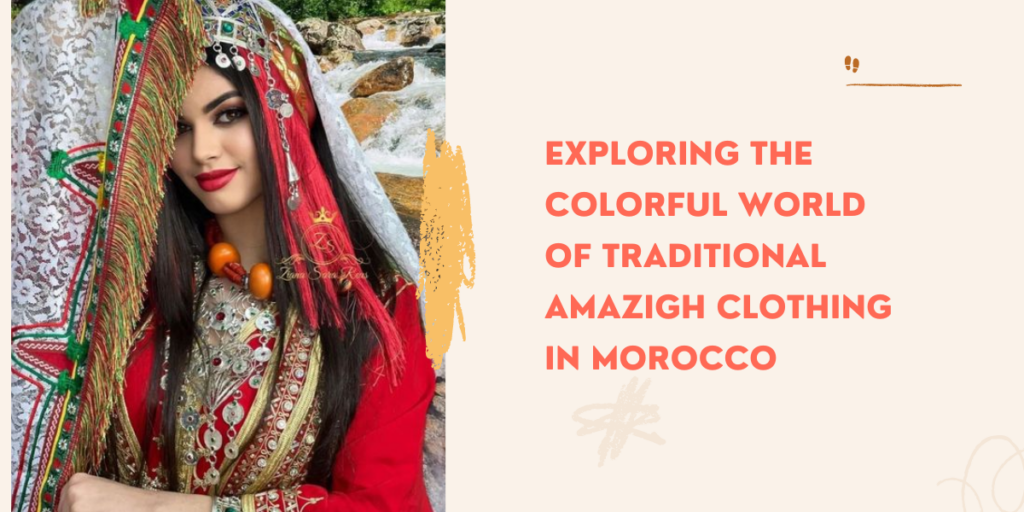Have you ever seen traditional Moroccan Amazigh clothing at some point and been struck by its beauty? Traditional Moroccan clothing, with its vibrant colors, intricate patterns, and exquisite craftsmanship, reflects the beauty of the country and its diverse landscapes. Janice is a professional fashion blogger who grew up in Moroccan culture and has a deep understanding of traditional amazign clothing. With Janice leading the way, we believe in celebrating diverse cultures and empowering individuals to embrace their unique styles. Whether you’re planning a trip to Morocco or simply curious about the rich Moroccan culture, this guide is your passport to discovering the beauty and significance of Amazigh clothing. In this article, we’ll take you on a journey through the origins, colors, and popular clothing items of Amazigh fashion.
Origins Of Moroccan Amazigh Clothing
Amazigh clothing, also known as Berber clothing, has a rich history deeply intertwined with the indigenous Amazigh people of North Africa. The Amazigh culture is one of the oldest in the region, dating back thousands of years. Throughout history, the Amazigh people have proudly maintained their distinct identity and traditions, which are reflected in their clothing.
The origins of Amazigh clothing can be traced back to the ancient civilizations that once thrived in North Africa. The Amazigh people have been influenced by a multitude of cultures, including Phoenician, Roman, Arab, and Andalusian civilizations. Each influence has contributed to the unique tapestry of Amazigh fashion, creating a harmonious blend of cultural heritage.
The Colorful World Of Traditional Moroccan Amazigh Clothing
Embark on a mesmerizing journey into the kaleidoscopic realm of traditional Moroccan Amazigh clothing, where vibrant hues, mesmerizing patterns, and impeccable artistry converge to create sartorial masterpieces that epitomize the rich cultural heritage of Morocco. Amazigh garments are renowned for their radiant palette, intricately woven patterns, and meticulous craftsmanship, serving as a captivating homage to the country’s diverse landscapes and natural wonders.
Drawing inspiration from the resplendent desert landscapes, Amazigh clothing captures the fiery allure of vibrant reds and oranges, mirroring the sun’s warmth and the captivating hues of the sandy dunes. These bold tones exude a sense of passion and vitality, embodying the spirit of the Amazigh people and their close connection to the arid terrain.
In striking contrast, the lush greens of the majestic Atlas Mountains find their reflection in the intricate weaves and delicate embroideries of Amazigh attire. Like verdant tapestries, these garments pay homage to the fertile valleys and lush landscapes, symbolizing harmony with nature and the bountiful beauty that surrounds the Amazigh communities.
Beyond the captivating color palette, the artistry and craftsmanship displayed in Amazigh clothing are simply breathtaking. Meticulously handcrafted by skilled artisans, often women who have inherited ancient weaving techniques, these garments serve as testaments to the cultural legacy and dedication of the Amazigh people. Each stitch, bead, or thread tells a story, preserving ancestral knowledge and celebrating the mastery of textile creation.

Popular Amazigh Clothing Items
Traditional Morocco Amazigh clothing encompasses a wide range of garments, each with its distinct style and purpose. Let’s explore some of the popular clothing items that define Amazigh fashion:
The Timeless Kaftan: An Iconic Garment
Step into the world of Amazigh fashion with the timeless kaftan, a garment that has transcended generations with its enduring elegance. This ankle-length robe, known for its loose-fitting silhouette, is a symbol of grace and femininity. Crafted from luxurious fabrics like silk, satin, or velvet, the kaftan showcases intricate embroidery, sparkling sequins, and delicate beads. Its exquisite embellishments add an extra touch of sophistication, making it the perfect choice for special occasions and celebrations.
The Versatile Djellaba: A Cloak of Comfort
Embrace both style and functionality with the versatile djellaba, an iconic Amazigh garment cherished for its practicality. This loose-fitting cloak, traditionally made from warm wool, provides cozy warmth during the chilly winter months. The djellaba features a hood and can be adorned with decorative trimmings, showcasing the wearer’s flair and creativity. Loved by both men and women, it has become a staple in everyday Amazigh fashion, offering both comfort and protection.
The Vibrant Tunic: A Burst of Color
Experience a burst of vibrant colors and eye-catching patterns with the Amazigh tunic, known as the “takchita” or “tehmiss.” This long, flowing dress with wide sleeves is a celebration of joy and festivity. Adorned with bold patterns and bright hues, the tunic beautifully showcases the rich craftsmanship and artistic expression of Amazigh culture. It is commonly worn during festive occasions and weddings, becoming a symbol of cultural pride and celebration.
Traditional Moroccan Amazigh Clothing In Modern Life
Influence of Western Clothing
In the modern era, the global exchange of ideas and cultural influences has inevitably impacted traditional clothing styles, including those of the Amazigh community in Morocco. The introduction of Western fashion trends has brought about changes in clothing preferences and designs. While traditional Amazigh garments remain deeply rooted in their cultural heritage, elements of Western fashion have found their way into contemporary interpretations.
The interaction between Western and Amazigh clothing can be seen in the fusion of fabrics, silhouettes, and embellishments. For instance, Amazigh women may incorporate Western textiles, such as chiffon or satin, into their traditional dresses, creating a captivating blend of traditional and contemporary elements. Similarly, men’s attire may feature Western-inspired tailoring techniques, introducing a touch of modernity while preserving the essence of Amazigh fashion.
Changes in Color and Pattern
Color and pattern play a vital role in traditional Moroccan Amazigh clothing, reflecting cultural symbolism and aesthetic preferences. Over time, the use of colors and patterns in traditional garments has undergone subtle transformations influenced by contemporary trends and personal expression.
In the past, natural dyes obtained from plants and minerals were predominantly used to color the fabrics. Earthy tones like ochre, indigo, and saffron were prevalent, symbolizing the connection between the Amazigh people and their natural surroundings. However, the availability of synthetic dyes introduced a wider range of vibrant colors, expanding the palette of Moroccan Amazigh fashion.
Similarly, pattern variations have emerged, showcasing the creativity and adaptability of Amazigh artisans. Traditional geometric motifs, inspired by nature and architectural elements, have been preserved, but contemporary patterns featuring abstract designs or fusion with other cultural symbols have also gained popularity. These changes in color and pattern demonstrate the evolution of Moroccan Amazigh clothing as it continues to embrace cultural heritage while embracing modern influences.

Conclusion
In conclusion, exploring the colorful world of traditional Amazigh clothing in Morocco offers a captivating journey into the rich cultural heritage of the indigenous Amazigh people. The origins of Amazigh clothing date back thousands of years and have been influenced by various civilizations, resulting in a harmonious blend of cultural traditions. The vibrant colors, intricate patterns, and impeccable craftsmanship of Amazigh garments reflect the beauty of Morocco’s diverse landscapes and natural wonders. By delving into the mesmerizing realm of MoroccoAmazigh fashion, we celebrate the uniqueness of cultural attire and empower individuals to embrace their style.
FAQs
What colors are commonly used in Moroccan Amazigh clothing?
Moroccan Amazigh clothing showcases a vibrant palette inspired by the country’s diverse landscapes. It includes bold tones of reds and oranges reminiscent of the desert and lush greens that reflect the Atlas Mountains’ beauty.
What is Moroccan traditional dress called?
Moroccan Takchita. The Takchita is the quintessential Moroccan traditional dress that holds great cultural significance. Its intricate craftsmanship, vibrant colors, and rich history make it a cherished garment among Moroccan women. Whether worn during weddings or festive occasions, the Takchita exudes elegance and represents the pride and dignity of Moroccan women.
How is Moroccan Amazigh clothing crafted?
Moroccan Amazigh clothing is meticulously handcrafted by skilled artisans, often women who have inherited ancient weaving techniques. Each stitch, bead, or thread tells a story and preserves ancestral knowledge, showcasing the dedication and cultural legacy of the Amazigh people.
How does Moroccan Amazigh clothing celebrate cultural heritage?
Moroccan Amazigh clothing embodies the rich cultural heritage of the Amazigh people through its vibrant colors, intricate patterns, and impeccable craftsmanship. Each garment reflects the connection to nature, ancient traditions, and the enduring beauty of Moroccan culture.
